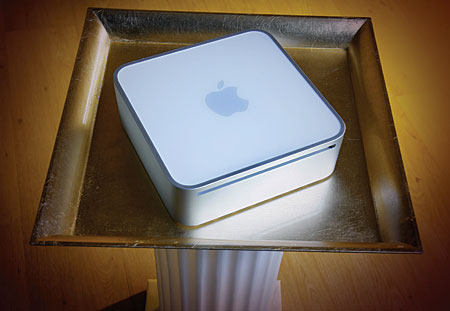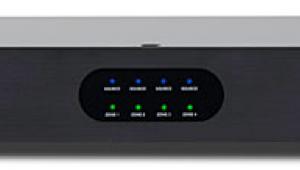Apple Mac mini with Intel Core Duo Processor
A while back, we Home Theater drones were all on Macs, and life was good. Then, one day, the powers that be told us that the bulk of us were switching to PC, and that was that. I had a few annoying differences to work through, but I eventually forgot my first real computer. And then the Mac mini showed up for review in its pretty white cardboard box, and it reminded me of the experience of bumping into a friend from the old neighborhood: familiar, sure, but with a lot of catching up to do.

Although the Mac mini has been around for more than a year, the big recent news has been the switch from Apple's own internal processors to Intel CPUs, either the 1.5-gigahertz Core Solo or the 1.66-GHz Core Duo—new handles for Intel's multitasking marvel, the dual-core processor. These two preconfigured versions of the mini offer "good" and "better" specs. I reviewed the latter. Both share an identical form factor, which is breathtakingly compact and has a metal perimeter topped by a goes-with-everything white plastic roof adorned with the Apple logo. The front edge features a slot for the SuperDrive, which can do almost everything with optical media, including burning to dual-layer DVD. Not surprisingly, power comes by way of an external brick in the AC cord, which you won't have to see once you tuck it behind other gear.
BYODKM
The sparsely bundled Mac mini supports the Apple philosophy of "BYODKM," or "Bring your own display, keyboard, and mouse." Fortunately, Apple also loaned me their optional wireless keyboard and wireless optical mouse. I highly recommend both if you intend to make this a living-room computer, as I did for the past month. The mini also offers digital optical audio output—sort of—via a novel dual-use audio port. It mates with a standard analog stereo minijack or an optional third-party Belkin adapter (see sidebar), which passes the raw digital optical signal. The computer supports Dolby Digital passthrough but not DTS. There is also a small built-in mono speaker. The single dedicated video output is DVI, although Apple includes a VGA adapter. An adapter for both composite and S-video is available separately. The Mac mini is intrinsically a desktop computer, but its many hardware and software refinements also make it a definite candidate for the home theater.
After the initial setup—only a couple of minutes and some easy questions—future boots took only about 20 seconds. The mini automatically detected my 802.11g LAN and asked if I wanted to connect to this nonsecure network. It also integrates Bluetooth 2.0 for further wireless interoperability. I confirmed that there is indeed a fan inside. It's all but silent beneath typical room noise, a feat that most HTPCs can't seem to accomplish. I tend to leave computers powered on for long stretches, and I noticed that a tremendous amount of heat spews out of the mini's back vents.

From the factory, the Mac mini defaults to the screen-gorging Overscan mode. If you deselect this mode via the Preferences menus (then Display, then Options), the image size will reduce. Some TV remotes can help you center the resulting desktop, which is surrounded by black borders. The effective onboard calibration tools for the computer image include color-temperature tweaking to best match your specific display. For an ideal presentation, you should also try adjusting your display's video menus. I found that the picture looked best with my TV's noise reduction turned off—your mileage may vary.
The preloaded Front Row entertainment interface and OS X 10.4 Tiger operating system work together seamlessly to provide an exquisite user experience that gently transitions between more diverting and more serious tasks. Front Row plays selected videos in their own angled windows while you sort through titles, for example, and can then return to the Tiger desktop with a subtle dissolve and zoom. The appropriately tiny IR remote is reminiscent in size and styling of the iPod shuffle. It brings up the Front Row main menu, selects and plays video or music, and also navigates other applications like QuickTime Player and the DVD player. One touch starts or pauses a movie or song. You can also view and manipulate digital photos. After a few-second setup, the mini located the hundreds of JPEGs on my networked PC and could download them via Ethernet. It similarly acquired my much larger music collection, and the latest version of iTunes promptly digested it.
What's On?
DVDs play at a maximum resolution of 480p via the DVI output. They tend to take on an unpleasant digital look, though, with visible decompression that doesn't appear to be big-screen ready. What else, then, are you to watch? One glaring omission amid all of this happy minimalism is a TV tuner, and therefore any sort of integrated DVR functionality. Elgato offers the Plextor ConvertX PVR add-on as a software solution, but this approach thwarts the Mac mini's austere aesthetic. In my opinion, nothing should be visibly connected that's more conspicuous than the occasional visiting iPod. The Internet is a limitless repository of content, and Apple makes available a growing collection of clips—mostly movie trailers—in true high definition, all the way up to 1080p resolution. Note that you cannot permanently download QuickTime HD videos (you can only stream them) without the $30 QuickTime Pro upgrade. Although the mini's versatility as a high-definition source is extremely limited, its quality is outstanding, as on the squeaky-clean coming attractions for Disney/Pixar's Cars or the hypnotically realistic CG hairs on Fox's Ice Age: The Meltdown critters. The music visualizer's constantly changing graphics also look spectacular in HD.
The QuickTime player also supports MPEG-1, MPEG-4, and H.264 video formats, among others, and you can download additional media players with further video codecs from third parties. Of course, which videos you acquire in these formats, and where (and how) you acquire them, are your own business. Home movies and public-domain curiosities are all well and good, but, for tried-and-true Hollywood entertainment, video downloads via iTunes are an interesting alternative to cable/satellite video on demand. Most of Apple's current TV-series selections are comprehensive, presenting every episode for sale, updated weekly. The half-hour or full-hour installments can become pricey at $1.99 each, or in the vicinity of $30 or more for some Season Passes. If Mac minis in the living room catch on, perhaps iTunes will work out some less expensive rental deal. Video files downloaded at slower-than-real-time via a shared DSL line. By comparison, my primary PC can download a song in a few seconds or a music video in about a minute using the same Internet access.
On my 50-inch Samsung DLP, the old-school ink and paint of Disney's short Ferdinand the Bull shows so much compression, the background appears to be throbbing at times. More modern animation like South Park fares a little better, still with some artifacting in the textures. Meanwhile, a live-action show like The Office shows some mild blockiness on the edges of objects. All the downloads were certainly watchable, but the DVI/HDTV display was not flattering, due to the iTunes videos' one-fourth of NTSC resolution (320 by 240). I do wish there were more content options, legally and easily, perhaps even high-def shows that you could set to download overnight due to the large file size. That might just be the killer home theater application that the Mac mini is missing.
Highlights
• The diminutive Mac mini rethought: DVI, digital audio output, Front Row interface
• Plays DVDs, CDs, and more, plus it displays digital photos, all via remote control
• Internet connectivity accesses a universe of audio/video content
- Log in or register to post comments






























































